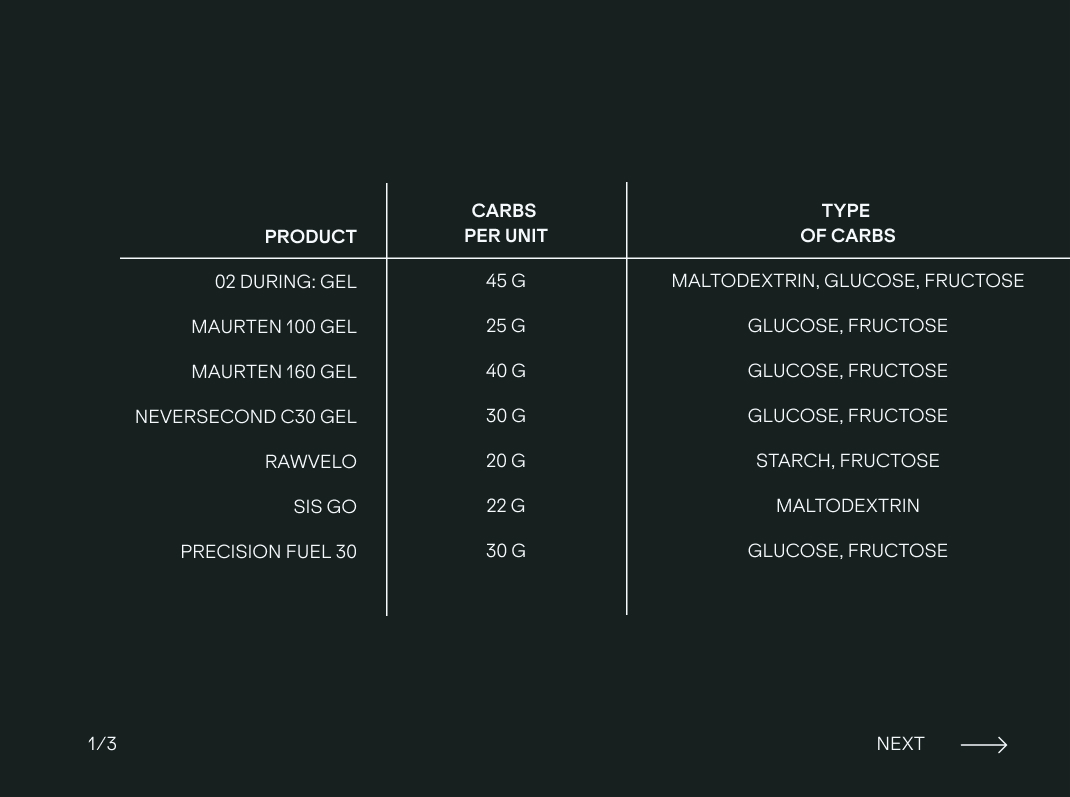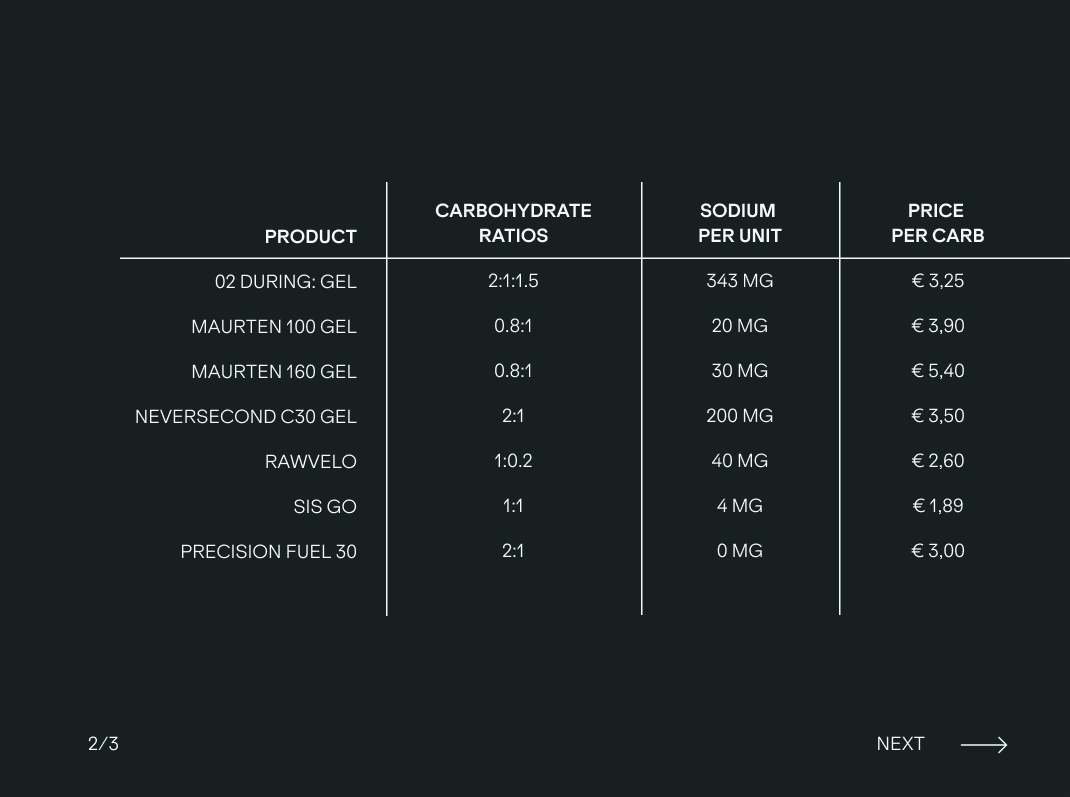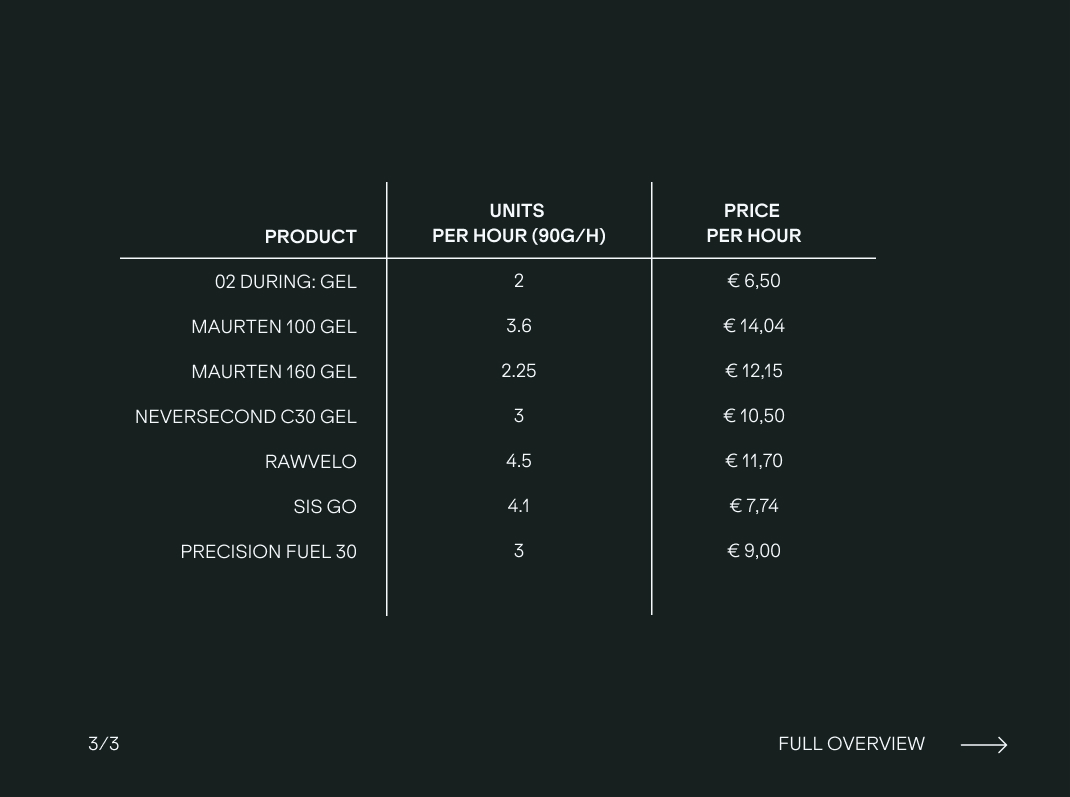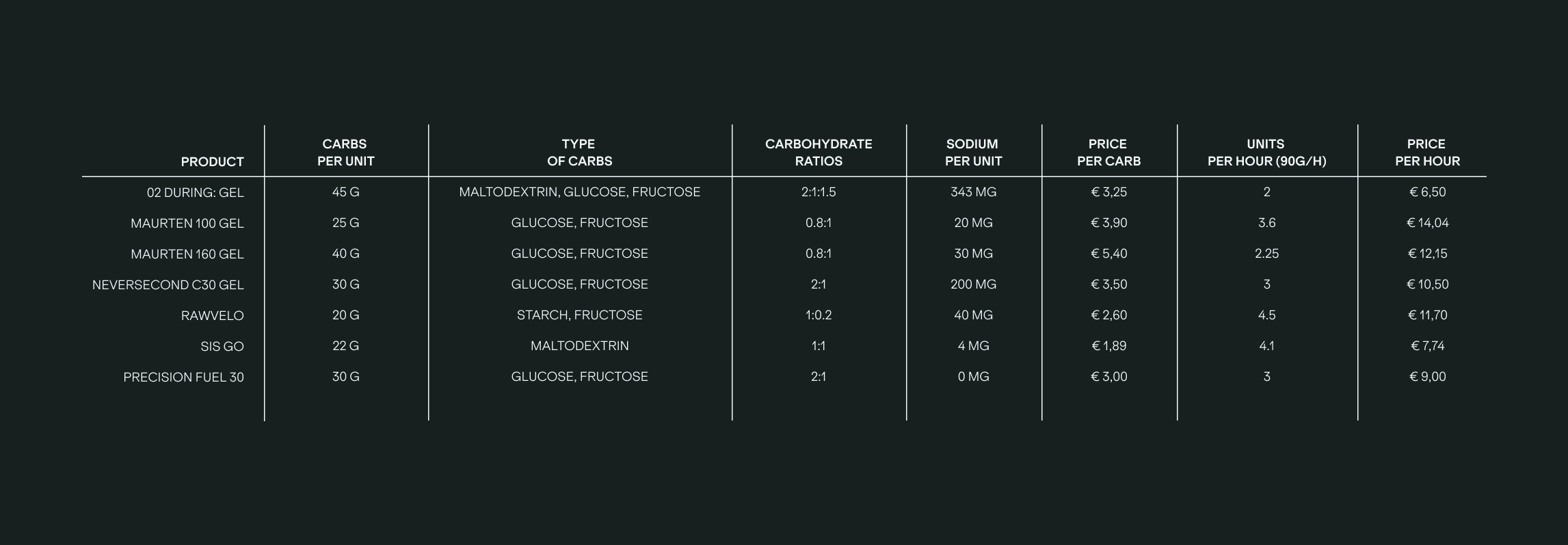Dein Einkaufswagen ist ziemlich leer
Zum Shop gehen
02 During: Gel - Explained and compared
Recently, we introduced 02 During: Gel, a high-energy gel that's packed with 45 grams of fast-absorbing carbohydrates and 343 mg of sodium - it contains the same functional formula as the 02 During: drink mix. We did that because we believe that in order to improve your performance, you should be able to plan your intake as effectively and efficiently as possible. Increasing the number of carbs per unit lowers the number of units you have to use per hour. This enables you to train with the same products that you compete with. And too often, we see athletes train with budget/low-quality products just to switch to premium brands before race day - hoping it will improve their performance, but often resulting in the opposite.
Your goal as a (power-)endurance athlete is to consume enough carbohydrates to maintain your energy balance. This is important for numerous reasons, but we wrote a different article about that. For medium-intensity activity ranging between one and two hours, your goal should be getting in 30-60 grams of carbs per hour. For high-intensity or two-hour plus sessions, you should (and can) consume 90 grams per hour or more to maintain that energy equilibrium. The research backing this is widely accepted, yet brands choose to push suboptimal products. This raises an interesting question: do companies have a moral obligation to deliver what’s best for the athlete, or is it the athlete’s responsibility to understand what they need? Or, in other words, and this is especially relevant within the (sports) nutrition market: are companies allowed to prioritise the company’s needs over the needs of the athlete/customer?
With this question in mind, we wanted to create a situation where the athlete’s needs are prioritised, and they are enabled to use the same products during training sessions without ever compromising on quality. To do this, we needed to check a few boxes:
- Minimise cost per carb if possible
- User-friendly packaging
- Reduce environmental impact
- Carry a lot of carbs as efficiently as possible
- Reduce cost per training and event drastically
- Mild flavour that's easily combined with the drink mix
- Minimise any risk of gastrointestinal issues
- Make it [very] easy to plan hourly intake
- Fully compatible with the drink mix
- Free of unnecessary additives and nutrients that could compromise main function
02 During: Gel
After a year of R&D, testing numerous different samples, working closely with both elite and professional athletes, and optimising production, we introduced our response to a changing market: 02 During: Gel. We made the following choices:
Carbohydrates: 45 g
Carbohydrates are stored in your body as glycogen, primarily in the liver and muscle tissue. If your diet is good, the liver (typically) holds 80-100g of glycogen, and muscle tissue holds somewhere between 300-500g of glycogen. However, this doesn't mean both storage types are available for exercise. The glycogen stored in your liver is used to maintain blood glucose levels, and it's the glycogen stored in your muscles that is used during exercise. If you train more than three times a week, at high intensity (zone 3-5), or you train for longer than two hours, preserving your muscle glycogen is crucial because you need certain minimum levels of muscle-stored glycogen to maintain your training intensity throughout the week. Therefore, you want to finish each training session as "fresh" as you started it, nourishing your "glycogen threshold" to maximise the benefits of every training.
Carbohydrate ratio: 2:1:1.5
Since carbohydrates are the main energy source during prolonged or high-intensity exercise, the main ingredient of the product should be carbohydrates. What to look for in a gel is a specific carb ratio, as this determines how the carbs are processed and how much you can process per hour. 02 During contains a mixture of carbohydrate sources as this enables your body to absorb and burn more fuel during exercise. Under normal circumstances, glucose uptake is limited to approximately 60 g per hour. The intake of multiple carbohydrate sources, like fructose, elevates carbohydrate absorption in the intestine. Furthermore, the use of multiple carbohydrate sources is less likely to cause GI issues. The ratio maltodextrin:glucose:fructose of 2:1:1.5/2:1 has been shown to elevate the rate of appearance of systemic glucose/lactate compared to an isocaloric amount of glucose only. So, ideally, you’re looking for a 2:1:1.5 or 2:1 maltodextrin/glucose:fructose ratio, simply because your body can handle that ratio with the least risk of gastrointestinal issues.
Sodium: 343 mg
Sodium, the main electrolyte lost in sweat and the only one known to enhance performance during exercise, regulates your fluid balance. How much sodium you lose per litre of sweat per hour is very personal. Some athletes lose as little as 200mg/L of sweat, while others can lose around 1.500mg/L (750mg/L on average). Other electrolytes (potassium, calcium, magnesium) are also lost in sweat, but in minimal quantities. A healthy diet is needed to keep these electrolyte concentrations at desired levels in the body. 03 After already contains these electrolytes, so there is no additional benefit to adding them to 02 During. The recommendation is to consume a sports drink with 0.5 – 0.7 g/L sodium for shorter than three hours and 0.7 – 1 g/L sodium for exercise sessions lasting longer than three hours. To one serving of 45 g, 500-730 mL water should be added, so one serving should contain 343 g of sodium. As carbohydrates are co-transported with sodium, this creates a gradient that further improves the absorption of water.
02 During compared
The development of the gel took a little longer than expected, simply because we felt we only had one shot at this. The market is too competitive to make mistakes, and with players like Maurten, NeverSecond, Science in Sport (SiS), and Precision Fuel, the competition is fierce. But what is the actual difference between the different gels? To create a comprehensive comparison, we need to cover the following subjects:
- Carbs per serving/unit
- Types of carbs
- Carb-ratios
- Sodium per serving/unit
- Price per unit (at The Feed)
- Price per carb
- Units per hour needed (at 90g/h) & environmental impact
- Price per hour (at 90 g/h)
We want to emphasise that these different gels all have their own story, very loyal customer bases (and for good reasons), and, of course, tastes. We can't decide which works best for you personally. We simply wanted to create an objective overview so you can make an informed decision about how you plan your nutrition intake.
As you can see in the chart below, solely looking at price per unit creates a disoriented view of what it costs to train with a specific brand/product, as a low price per unit can still be expensive if you need to increase your hourly intake to three or four units per hour to get in 90 grams of carbs. This difference only becomes bigger when you want to increase your hourly intake to 120/135 g/h - but that’s only advised for trained and guided athletes. Some of these products don’t allow 90g/h as they use a single type of carbohydrate.
In conclusion, the development of 02 During: Gel represents our commitment to providing athletes with superior, scientifically-backed nutrition options. Our comprehensive analysis and comparison with other products in the market underscore our dedication to combining quality, efficiency, and cost-effectiveness. We believe that by focusing on the specific needs of athletes, we can offer a product that not only enhances performance but also aligns with the principles of health and sustainability.




